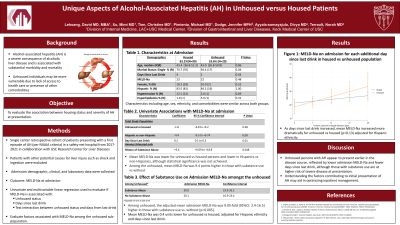Back


Poster Session B - Monday Morning
Category: Liver
B0529 - Unique Aspects of Alcohol-Associated Hepatitis in Unhoused versus Housed Patients
Monday, October 24, 2022
10:00 AM – 12:00 PM ET
Location: Crown Ballroom

Has Audio

David Lehoang, MD, MBA
Keck School of Medicine, University of Southern California
Los Angeles, CA
Presenting Author(s)
David Lehoang, MD, MBA1, Mimi Xu, MD1, Christine Tien, MD1, Michael Pimienta, MD2, Jennifer L. Dodge, MPH1, Divya Ayyala-Somayajula, MD1, Norah A. Terrault, MD, MPH1
1University of Southern California, Los Angeles, CA; 2Keck School of Medicine of USC, Los Angeles, CA
Introduction: Severe AH is associated with substantial morbidity and mortality. Unhoused individuals may be more vulnerable due to lack of access to health care or presence of other comorbidities. We sought to understand the association between housing status and severity of AH at presentation.
Methods: Single center retrospective cohort of patients presenting with a first episode of AH (per NIAAA criteria) in a safety-net hospital from 2017-2021. Admission demographic, clinical, and laboratory data were collected with univariate and multivariable linear regression used to evaluate the association between admission MELD-Na and unhoused status. The interaction between days since last drink and housing status was assessed. Unique factors associated with MELD-Na among the unhoused population were also evaluated.
Results: Of 119 adults with AH, 20 (16.8%) were unhoused. Unhoused adults were more likely to be single (94.4 vs 70.7%, p=0.04), present fewer days since last drink (1.0 vs 4.0, p=0.03), and have lower median MELD-Na (21.8 vs 23.0, p=0.48). Characteristics including age, sex, ethnicity, and comorbidities were similar across both groups. On univariate analysis, mean MELD-Na was 1.8 units lower for unhoused vs housed persons (p=0.48), 4.4 units lower in Hispanics vs non-Hispanics (p=0.09), and 1.4 units higher per week increase since last drink (p=0.001). After adjustment for Hispanic ethnicity and days since last drink, the mean MELD-Na was 0.4 units lower for unhoused vs housed, though not statistically significant (p=0.87). As days since last drink increased, mean MELD-Na increased more dramatically for unhoused vs housed (p=0.13) (Figure). Among the unhoused, mean MELD-Na was 9.4 units higher in those with substance use (current or history) vs without (p=0.048) and 4.7 units lower for Hispanic vs non-Hispanic (p=0.15) in univariate analysis. After adjustment for time since last drink, mean MELD-Na was 9.95-fold (95%CI: 3.4-23.4) higher in those with substance use vs without (p=0.005) reflecting a mean admission MELD-Na of 30.0 (95%CI: 23.9-35.2) vs 20.1 (95%CI: 16.9-23.4) respectively.
Discussion: Unhoused persons with AH appear to present earlier in the disease course, reflected by lower admission MELD-Na and fewer days since last drink, although those with substance use are at higher risk of severe disease at presentation. Understanding the factors contributing to initial presentation of AH may aid in optimizing inpatient management.

Disclosures:
David Lehoang, MD, MBA1, Mimi Xu, MD1, Christine Tien, MD1, Michael Pimienta, MD2, Jennifer L. Dodge, MPH1, Divya Ayyala-Somayajula, MD1, Norah A. Terrault, MD, MPH1. B0529 - Unique Aspects of Alcohol-Associated Hepatitis in Unhoused versus Housed Patients, ACG 2022 Annual Scientific Meeting Abstracts. Charlotte, NC: American College of Gastroenterology.
1University of Southern California, Los Angeles, CA; 2Keck School of Medicine of USC, Los Angeles, CA
Introduction: Severe AH is associated with substantial morbidity and mortality. Unhoused individuals may be more vulnerable due to lack of access to health care or presence of other comorbidities. We sought to understand the association between housing status and severity of AH at presentation.
Methods: Single center retrospective cohort of patients presenting with a first episode of AH (per NIAAA criteria) in a safety-net hospital from 2017-2021. Admission demographic, clinical, and laboratory data were collected with univariate and multivariable linear regression used to evaluate the association between admission MELD-Na and unhoused status. The interaction between days since last drink and housing status was assessed. Unique factors associated with MELD-Na among the unhoused population were also evaluated.
Results: Of 119 adults with AH, 20 (16.8%) were unhoused. Unhoused adults were more likely to be single (94.4 vs 70.7%, p=0.04), present fewer days since last drink (1.0 vs 4.0, p=0.03), and have lower median MELD-Na (21.8 vs 23.0, p=0.48). Characteristics including age, sex, ethnicity, and comorbidities were similar across both groups. On univariate analysis, mean MELD-Na was 1.8 units lower for unhoused vs housed persons (p=0.48), 4.4 units lower in Hispanics vs non-Hispanics (p=0.09), and 1.4 units higher per week increase since last drink (p=0.001). After adjustment for Hispanic ethnicity and days since last drink, the mean MELD-Na was 0.4 units lower for unhoused vs housed, though not statistically significant (p=0.87). As days since last drink increased, mean MELD-Na increased more dramatically for unhoused vs housed (p=0.13) (Figure). Among the unhoused, mean MELD-Na was 9.4 units higher in those with substance use (current or history) vs without (p=0.048) and 4.7 units lower for Hispanic vs non-Hispanic (p=0.15) in univariate analysis. After adjustment for time since last drink, mean MELD-Na was 9.95-fold (95%CI: 3.4-23.4) higher in those with substance use vs without (p=0.005) reflecting a mean admission MELD-Na of 30.0 (95%CI: 23.9-35.2) vs 20.1 (95%CI: 16.9-23.4) respectively.
Discussion: Unhoused persons with AH appear to present earlier in the disease course, reflected by lower admission MELD-Na and fewer days since last drink, although those with substance use are at higher risk of severe disease at presentation. Understanding the factors contributing to initial presentation of AH may aid in optimizing inpatient management.

Figure: Figure 1: MELD-Na on admission for each additional day since last drink in housed vs unhoused population
Disclosures:
David Lehoang indicated no relevant financial relationships.
Mimi Xu indicated no relevant financial relationships.
Christine Tien indicated no relevant financial relationships.
Michael Pimienta indicated no relevant financial relationships.
Jennifer Dodge indicated no relevant financial relationships.
Divya Ayyala-Somayajula indicated no relevant financial relationships.
Norah Terrault: DURECT Corp – Grant/Research Support. Gilead Sciences – Grant/Research Support. Glaxo-Smith-Kline – Grant/Research Support. Helio Health – Grant/Research Support. Moderna (DSMB) – Advisory Committee/Board Member. Roche-Genentech – Grant/Research Support.
David Lehoang, MD, MBA1, Mimi Xu, MD1, Christine Tien, MD1, Michael Pimienta, MD2, Jennifer L. Dodge, MPH1, Divya Ayyala-Somayajula, MD1, Norah A. Terrault, MD, MPH1. B0529 - Unique Aspects of Alcohol-Associated Hepatitis in Unhoused versus Housed Patients, ACG 2022 Annual Scientific Meeting Abstracts. Charlotte, NC: American College of Gastroenterology.
